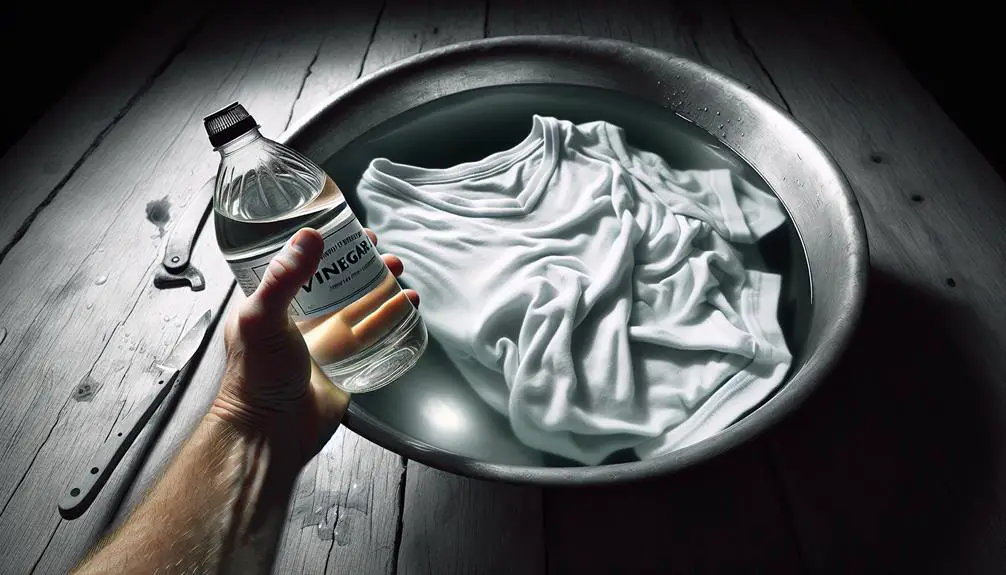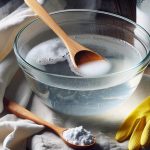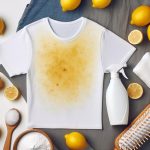So, you spilled bleach on your favorite shirt, and now it looks like a ghost from a laundry horror story. But fear not, there are ways to bring your garments back to life.
From natural remedies to color-correcting techniques, I'll guide you through the steps to rescue your clothes from the clutches of bleach.
Let's uncover the secrets to unbleaching clothes and revive your wardrobe in no time.
Table of Contents
Key Takeaways
- Use natural methods like lemon juice or vinegar to lighten bleach stains.
- Consider chemical treatments like hydrogen peroxide to restore fabric color.
- Employ color correction techniques to cover and blend bleach stains seamlessly.
- Practice prevention by separating laundry and avoiding bleach for long-lasting clothes.
Reasons for Clothes Bleaching
Bleaching of clothes often occurs unexpectedly due to accidental spills or splatters of bleach, a potent oxidizing agent. When bleach comes into contact with fabric dyes, a chemical reaction ensues, resulting in faded spots known as bleach stains. These stains are particularly noticeable on dark or colored clothes because the sodium hypochlorite in bleach breaks down the dyes present in the fabric fibers.
Understanding the science behind bleach stains is crucial for effectively treating and preventing them. Immediate action is key when dealing with bleach spills to minimize the damage caused to garments. To prevent bleach stains, it's essential to handle bleach carefully and ensure it doesn't come into contact with colored clothes. Separating laundry and following garment care labels can also help avoid accidental bleaching. By being mindful of how bleach interacts with fabrics, one can take proactive steps to protect their clothing from unsightly bleach stains.
Common Bleach Stain Scenarios
Upon encountering bleach stains on clothing, one may face various common scenarios that require specific approaches for effective stain removal.
- Yellow Stains on White Clothes: Bleach often leaves yellowish stains on white garments, making them appear discolored. To combat this, mix water and vinegar in equal parts and apply the solution to the affected area. Let it sit for a few minutes before rinsing thoroughly.
- Color Fading on Dark or Colored Fabrics: When bleach interacts with dark or colored fabrics, it can cause noticeable color fading. To tackle this issue, try diluting hydrogen peroxide with water and gently dabbing it onto the stained area. Rinse the garment afterward to remove any residue.
- Hard-to-Remove Stains: In some cases, bleach stains can be stubborn and challenging to eliminate completely. If traditional methods fail, consider seeking professional assistance to restore the garment to its original state. Professional services may offer specialized treatments tailored to the fabric and dye affected by the bleach.
Natural Methods to Reverse Bleaching
Hey there!
Let's talk about some natural ways to reverse bleaching on clothes.
We'll be looking at how lemon juice treatments, vinegar soaks, and baking soda pastes can help restore your garments.
These methods are simple, effective, and can be done right at home, offering a more eco-friendly approach to fixing bleach stains.
Lemon Juice Treatment
To effectively reverse bleach stains on clothes using natural methods, consider utilizing the power of lemon juice as a gentle bleaching agent. Lemon juice, with its citric acid content, can help lighten bleach stains on various fabric types.
Here are three key points to keep in mind when using lemon juice treatment:
- Apply lemon juice directly onto bleach stains and allow it to sit for a few hours before washing.
- Lemon juice is particularly effective for treating small bleach stains on clothes.
- For larger or stubborn bleach stains, repeating the lemon juice treatment multiple times can lead to better results.
Vinegar Soak Method
Consider soaking your clothes in a vinegar solution to effectively reverse bleach stains and restore color using natural methods. White vinegar is a powerful ally for light-colored garments affected by bleach stains. Its acidity helps in neutralizing bleach residue, minimizing the appearance of discoloration.
To fade bleach stains, mix water and white vinegar in a container, submerge the affected clothing, and let it soak for a few hours. After soaking, wash the clothes as usual to remove the vinegar smell and reveal the improved color.
This method offers a gentle approach to treating bleach stains, making it a valuable option for those looking to salvage their favorite garments without harsh chemicals.
Baking Soda Paste
For an effective and natural method to reverse bleach stains on clothes, try creating a baking soda paste. Baking soda paste is a simple yet powerful way to neutralize bleach stains and restore color to your garments. Here are some key steps to maximize the effectiveness of this method:
- Thick Paste: Ensure the baking soda paste is thick and spread evenly over the bleach-stained areas for optimal coverage.
- Even Application: Apply the paste uniformly on the affected spots to guarantee consistent color restoration.
- Gentle Removal: After allowing the paste to dry, gently brush it off using an old toothbrush to reveal the improved color underneath.
Consider using rubbing alcohol or fabric dye for additional color restoration if necessary.
Chemical Treatments for Unbleaching
When it comes to unbleaching clothes, exploring chemical treatments can be a game-changer.
Bleach neutralization methods, oxidation reduction reactions, and stain removal techniques are some key points to consider in this process.
These methods can be effective in restoring the color of your clothes and reversing the effects of bleach stains.
Bleach Neutralization Methods
To unbleach clothes effectively, various chemical treatments can be used to neutralize bleach stains and restore the original color of the fabric. Here are some effective methods for bleach neutralization:
- Hydrogen Peroxide: Mixing hydrogen peroxide with water can help counteract bleach stains, particularly on white clothes.
- Ammonia: When diluted with water, ammonia serves as another potent bleach neutralizer, especially for colored garments.
- Sodium Thiosulfate: This compound, commonly present in commercial bleach removers, is effective in reversing bleach stains on clothes.
Utilizing these chemical solutions can aid in neutralizing bleach stains and rejuvenating the color of your garments without causing damage.
Oxidation Reduction Reactions
After exploring effective methods like hydrogen peroxide and ammonia for neutralizing bleach stains on clothes, the focus now shifts to oxidation reduction reactions as chemical treatments for unbleaching garments.
Oxidation reduction reactions involve using specific products such as color removers or dyes to reverse bleach stains and restore the original color of the fabric. These chemical treatments work by counteracting the effects of bleach through carefully applied processes. Understanding the chemistry behind oxidation reduction reactions is crucial for successfully unbleaching clothes.
Stain Removal Techniques
Exploring various chemical treatments for unbleaching clothes, one effective option involves utilizing sodium thiosulfate to neutralize bleach stains and restore the original color of the fabric.
Here are some key points to consider when using sodium thiosulfate for fabric repair:
- Neutralizing Effect: Sodium thiosulfate counteracts the damaging effects of bleach by breaking down its molecules, allowing the fabric's color to return.
- Color Restoration: Applying a mixture of sodium thiosulfate and water can help revive the original color of clothes affected by bleach stains.
- Suitable for Dark Clothes: This chemical treatment is particularly effective for reversing bleach stains on colored, dark, and black garments.
Using sodium thiosulfate with care and following precise instructions is crucial for successfully unbleaching clothes and restoring their appearance.
Color Correcting Techniques
When correcting colors on clothes to cover bleach stains, it's essential to choose the right color corrector product. To begin, test a small area with the product to ensure it matches the fabric and won't cause further damage. If dealing with a small bleach stain on dark clothes, using a permanent marker that matches the garment's color can provide a quick fix. For larger areas or light-colored garments, opt for a color corrector specifically designed to repair the damage caused by bleach. Remember to follow the product instructions carefully for best results.
In case you're treating bleach stains on colored clothes, consider applying a dye that matches the original color. Work in a well-ventilated area and wear gloves to prevent skin irritation when using color correctors. Always prioritize safety while attempting to restore the color of your clothes.
Preventing Future Bleach Stains
To prevent future bleach stains on your clothes, always separate white and colored garments before doing laundry.
Tips to Prevent Future Bleach Stains:
- Avoid Bleach: Consider using color-safe bleach alternatives to prevent damaging colored garments. These alternatives are gentler on fabrics but still effective at whitening whites.
- Wear Old Clothes: When working with bleach or other cleaning products that can cause stains, wear old clothes that you don't mind getting ruined. This precaution can help protect your favorite outfits from accidental spills or splashes.
- Rinse the Fabric: If bleach accidentally spills on clothing, rinse the fabric immediately with cold water to help minimize the damage. The quicker you act, the better chance you have of removing bleach stains effectively. Remember to always treat stains promptly to avoid them setting in.
Frequently Asked Questions
Is It Possible to Unbleach Clothes?
Unbleaching clothes isn't feasible once bleach has done its damage. The chemical reaction removes color permanently, making restoration tricky. Prevention and proper care are key. If stains persist, professional help or creative solutions like dyeing might be necessary.
How Do You Fix Discolored Clothes?
To fix discolored clothes, I apply a baking soda paste or use lemon juice and vinegar to gently treat stains. Fabric dye or markers can cover bleach spots. I avoid harsh chemicals and rinse garments thoroughly after treatment.
How Do You Put Color Back on Bleached Clothes?
Putting color back on bleached clothes can be tricky, but dyeing them in a matching shade is a great solution. Follow dye instructions, use color removers if needed, and test a small area first for the best results.
Does Bleaching Clothes Ruin Them?
Bleaching clothes ruins them by fading colors, weakening fibers, and causing yellowish spots. It's a chemical reaction that's irreversible and especially damaging to delicate fabrics like silk. Handling bleach carefully is crucial to prevent irreversible damage.
- Tetron Fabric for Marine Applications: Durability and Use Cases - June 18, 2025
- Tetron Fabric for Outdoor Furniture: Weather Resistance and Care - June 18, 2025
- Tetron Fabric for Wall Coverings: Style and Application Tips - June 18, 2025





